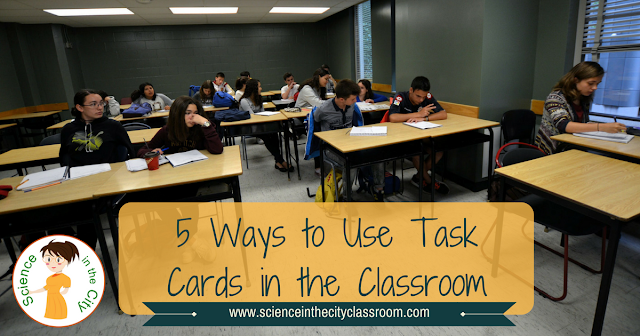
5 Ways to Use Task Cards in the Classroom
I looked out at my class, trying to get their attention as I stood at the board. It seemed, even to me, like the class period would never end. I was tired to trying to remind, redirect, and 'perform' to hold their attention.My class needed a change so that students were active and helping each other learn. I started researching task cards, and they quickly became a necessary part of my classroom. The focus changed so that the students were active, eager to participate, moving around the room, and even doing some self-reflection.
If you've research task cards before, you may see that many of the resources available are geared more towards elementary students, or to subject areas other than science. I want to share with you some great resources for more information on task cards, and the 5 ways that I find them most useful in my classroom. It really is possible for your students to be more engaged and accountable for their learning.
Tweet: Task cards can be a valuable tool to assess knowledge and keep students engaged in creative and differentiated ways.
Way 1: As Warm Ups
Task cards are already divided up into short single or double questions. They are a natural fit for a warm up. You can easily project one on the board, or put a copy of one on each table group for a warm up/quiz from yesterday. It should only take about 3-5 minutes for students to answer one task card, but you can quickly assess their comprehension and memory of yesterday's lesson. Where you have your students write their answer is your choice. I use this template for bellwork.Way 2: As Tickets Out
Similar to Way #1, you can easily hand out one task card (or a few differentiated task cards) copied on a quarter sheet of paper for students to record their answer and hand you on the way out. You could also project a single task card, or make a table copy as mentioned above and have students answer on a scrap sheet of paper, out loud, or in a notebook, depending upon your classroom procedures.
Way 3: Scoot (or a station variation)
Scoot, or stations, are great because they keep the students moving! They put an automatic time limit on students' work, and keep them more engaged because they are active.
In Scoot, the task cards are laid out around the room (maybe in order around the seats). Students move, but the task cards don't. Students are given a short time at a seat and then they move (or scoot) over one seat. They keep going this way until they have reached all the task cards, or run out of time.
Stations are similar, except I like to have the students work in groups. I might set up 4-6 task cards at a table group, or at a location around the perimeter of the room. Students will work in a group to answer those questions in a longer period of time (say 15 minutes). Then they rotate. Or they can switch cards with another group.
In Scoot, the task cards are laid out around the room (maybe in order around the seats). Students move, but the task cards don't. Students are given a short time at a seat and then they move (or scoot) over one seat. They keep going this way until they have reached all the task cards, or run out of time.
Stations are similar, except I like to have the students work in groups. I might set up 4-6 task cards at a table group, or at a location around the perimeter of the room. Students will work in a group to answer those questions in a longer period of time (say 15 minutes). Then they rotate. Or they can switch cards with another group.
Way 4: Digitally (and there are lots of options here)
Two pretty comprehensive resources on digital task cards were already written by Study All Knight
and Erintegration. Now that Google Classroom has added even more options for differentiation, this opens even wider possibilities. Read more about the differentiation options here. Google just made it so easy to assign different work to different students!!
Digital allows students to go through the cards in a different format, as forms,
Digital allows students to go through the cards in a different format, as forms,
Way 5: Quiz your Partner
In this method the task cards are set up more like flashcards. You can give on partner the answer key for a few cards, and have him or her quiz a partner. You can also write the answer on the back of the cards ahead of time, making it easier to quiz.If they miss the question, they have the answer and both partners have to work together to figure out why it is the correct answer.
Of course, you can let them keep score if you want. This can get very competitive!
You can see any of my task card resources here. They can all be utilized in the ways discussed here, and many others. For more resources on task cards in general, the best resource I know is here. For resources more specific to science, and some different creative ideas, you may want to check out this post by Kesler Science.
I'd love to hear if you use task cards in your classroom so you aren't the teacher standing up the board trying to hold your students attention!









Great ideas! Thank you for sharing! :)
ReplyDeleteBest ideas I have found yet! These are so great😊
ReplyDeleteLove these task card ideas! Thank you!
ReplyDeleteThank so much. Glad they were helpful :)
ReplyDelete